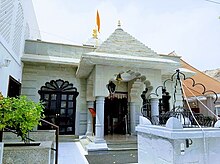Religion in Oman
Even though the Oman government does not keep statistics on religious affiliation, statistics from the US's Central Intelligence Agency state that adherents of Islam are in the majority at 85.9%, with Christians at 6.5%, Hindus at 5.5%, Buddhists at 0.8%, Jews less than 0.1%. Other religious affiliations have a proportion of 1% and the unaffiliated only 0.2%.
Islam
Most Omanis are Muslims, most of whom follow the Ibadi[2] School of Islam, followed by the Twelver school of Shia Islam, the Shafi`i school of Sunni Islam, and the Nizari Isma'ili school of Shia Islam.[3] Virtually all non-Muslims in Oman are foreign workers. Non-Muslim religious communities include various groups of Jains, Buddhists, Zoroastrians, Sikhs, Jews, Hindus and Christians. Christian communities are centred in the major urban areas of Muscat, Sohar and Salalah. These include Catholic, Eastern Orthodox and various Protestant congregations, organising along linguistic and ethnic lines. More than 50 different Christian groups, fellowships and assemblies are active in the Muscat metropolitan area, formed by migrant workers from Southeast Asia.
Other religions

There are also communities of ethnic Indian Hindus and Christians. Muscat has two Hindu temples. One of them is over a hundred years old. There is a significant Sikh community in Oman. Though there are no permanent gurdwaras, many smaller gurdwaras in makeshift camps exist and are recognised by the government. The Government of India had signed an accord in 2008 with the Omani government to build a permanent gurdwara but little progress has been made on the matter.[4]
There is also a small Jewish community. [5]
Freedom of religion
This section needs expansion. You can help by adding to it. (September 2020) |
References
- ^ "Middle East OMAN". CIA The World Factbook.
- ^ Vallely, Paul (19 February 2014). "Schism between Sunni and Shia has been poisoning Islam for 1,400 years - and it's getting worse". The Independent.
Oman is unusual because its Sunni and Shia residents are outnumbered by a third sect, the Ibadis, who constitute more than half the population.
- ^ "Aga Khan announces first Ismaili Centre in Middle East". 13 December 2003. Retrieved 28 September 2020.
- ^ "Oman to allow temple, gurdwara". Sify.com. 24 November 2010. Retrieved 14 January 2014.
- ^ http://archive.diarna.org/site/detail/public/906/
